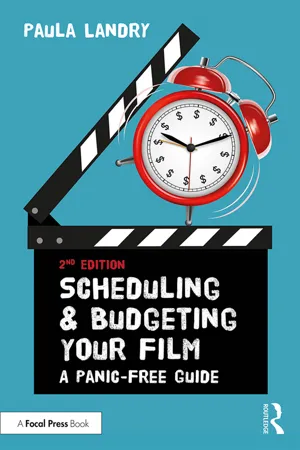QUESTION: What is Production Management?
ANSWER: The planning, organizing and managing of the resources and actions required to successfully create a film from a concept or script.
Every film is constructed; the result of a combination of resources
AKA—
places, people and equipment—with the common goal of capturing footage to be edited together to tell a story. Even documentaries and reality television are created and creation requires planning.
Production management is that preparation, representing the business component of show business—answering practical questions such as: When will that scene be shot? Who will shoot it and Where? What role does that actor play and Why does that equipment need to be purchased, rather than rented? Where will we rent these props, How long do we need them and How many of those do we need? Where is the next location? What is all of this going to cost? Why do we need that additional location?
Production management is resource management: effectively
- Identifying
- Organizing and Scheduling
- Locating and Pricing
- Budgeting and Securing
—everything needed to create a film, so that each is available as needed, when required, for the best price possible.
When administrative factors are well managed, they contribute to the artistic process of filmmaking. Actors act, the director directs, the crew concentrates on the task at hand.
Scheduling and budgeting start once there is a project to manage. It assumes that a producer has assembled the basic elements of a film—a script, an end-use plan for the project and possibly a director, key actor—but every project is different.
A Production Manager (PM, or UPM, or Line Producer—we will use these interchangeably) is in a unique position regarding the filmmaking process. They must simultaneously be aware of small details, while maintaining a big picture view. The PM understands the past, present and future of the production—what’s currently happening now and what’s next.
Scheduling and Budgeting Your Film: A Panic-Free Guide presents a process to identify each resource needed to create, arrange, and price a film in the most efficient manner. The schedule and budget that you create may be different from someone else’s, but there are basic steps and a systematic way to approach them, commonly accepted in the industry, that can be applied to all types of films. This book offers guidelines to understand the process, do it yourself and streamline your process whenever possible.
The Schedule and Budget Relationship
A film’s schedule and budget are interdependent, hinging on the script. If one changes, so do the others. Based upon the script, the schedule and budget are the foundation of a film—they determine how quickly and efficiently it can be shot and completed.
For example, if you need a piece of equipment that is typically rented by the day and you add an additional day, your budget will increase.
For a shoot in Manhattan, our director and DP have requested an additional tripod. We call several vendors and find one that charges and find out that it will cost $20 per day to rent it, with a small discount if we rent for the entire 6-day week. The schedule below illustrates how renting this equipment for additional days will incur additional costs.
Table 1.1
| Equipment | Vendor | Days | Cost |
| Tripod | DCTV | 1 | $20.00 |
| | 2 | $40.00 |
| | 3 | $60.00 |
| | Entire Week (6 day) | $80.00 |
This situation brings up questions: in how many scenes will it be used? Can we group those scenes together to rent it for the shortest amount of time? Should we just pay a little more and rent it by the week for $80 and not worry about when in the schedule the tripod will be used? Going down a checklist: cost, personnel required, insurance, safety, transportation, storage; the convenience of having the extra tripod on hand outweighs any inconvenience for a relatively low cost. Working in production management raises questions with recurring themes: how will this new factor affect our power resources, human resources, time and monetary resources and constrictions of physical space and safety issues?
TIP: One of the fastest ways to reduce your budget is to cut entire script pages or shooting days from your schedule. These decisions aren’t made in a vacuum; you need the input of your team. Practical considerations require that the director agree that required scenes can be shot in the time allotted to do so.
For example, if you have scheduled one full day to shoot scene 23 and for some reason the shooting must be extended into the next day—this may impact your budget—paying for an additional day at that location, extending permits if necessary, equipment rental agreements, and employing extras or crew.
It’s cause and effect; additional time, locations, equipment or people generally increase time needed to shoot—impacting the schedule and, correspondingly, the budget. The reverse is true; shave time off of your schedule and the budget should go down.
Without a script or detailed concept, creating a film shooting schedule is difficult. And a budget doesn’t exist in a vacuum; it is a result of that schedule—when you need certain equipment or people, and for how long.
Film production works on a project basis. Crew and cast are freelancers; they must always plan the next job and may have employment scheduled immediately after your shoot. Extending their planned work time on your project may be out of the question, or tricky to arrange. Together the schedule and budget set the framework of possibilities for a film and resources required to create that film.
Who Manages the Schedule and Budget
There are many producer titles and ultimately one job: get the best fi...


